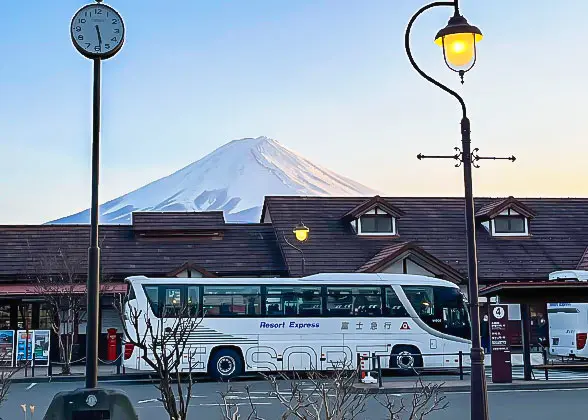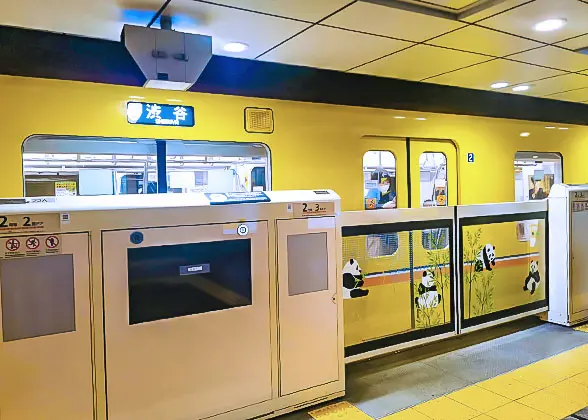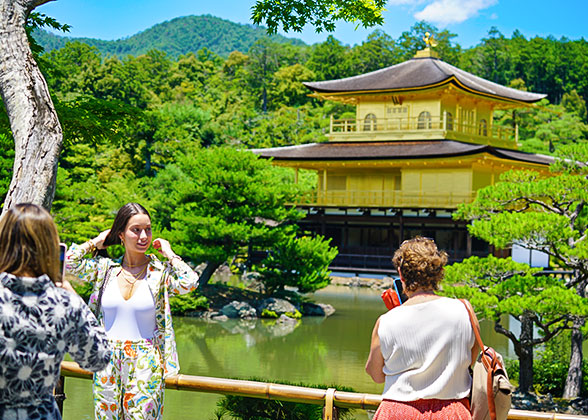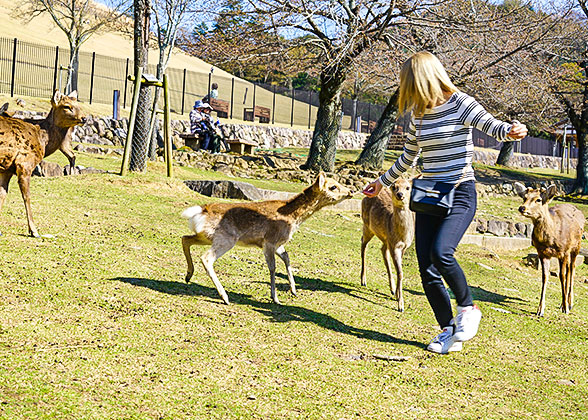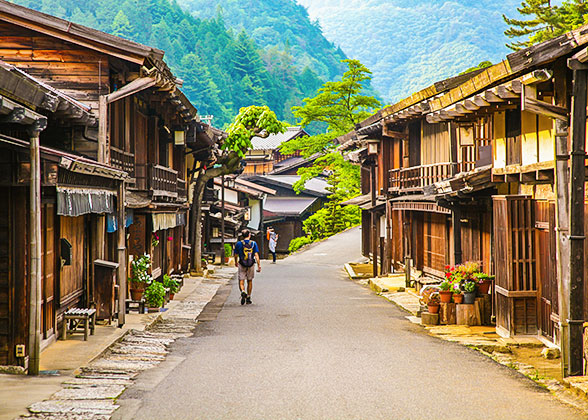Japan Transportation
Air
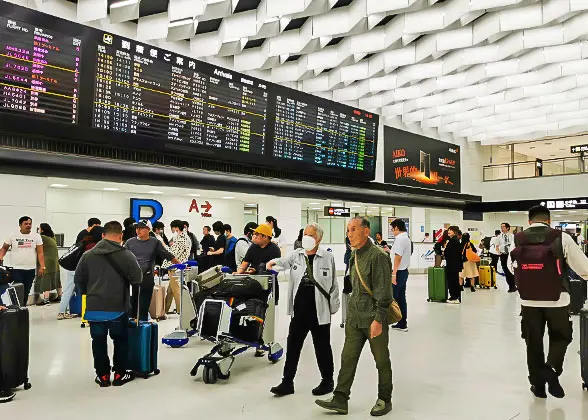 |
| Narita Airport |
Japan has 5 international airports for the exit and entry, including Haneda, Narita, Kansai, Osaka, and Chubu airports. Both Narita and Haneda airports are in Tokyo area. Narita International Airport (NRT) operates about 90 international flights from and to 90 cities in nearly 40 countries, mainly in the North America, Europe, East Asia and Southeast Asia. There are also some domestic flights to the main cities on the islands of Japan. Similarly, Haneda International Airport (HND) closer to Tokyo downtown has a great deal of international and domestic flights, too.
Kansai International Airport (KIX) and Osaka International Airport (ITM) are located in Osaka; Chubu Centrair International Airport (NGO) is near Nagoya. These three airports also has multiple international flights.
Besides, there are two-dozen domestic airports, scattered around Japan. Some of them, such as Okinawa Naha Airport and Sapporo New Chitose Airport, has a few flights to and from neighboring countries. As for domestic flights, a dozen of them fly between major cities daily, and a dozen of them serve every other day and on weekend, or every a few days.
It needs 1h 30min to fly between Tokyo and Sapporo, about 1h 30min between Tokyo and Hiroshima, 2h between Osaka and Sapporo, and 2h 40min to 3h between Tokyo and Naha. Also, it takes 1h 20min between Osaka and Tokyo, and a one-way trip costs 12,000-20,000 yen (USD 88-147); if it’s on a discount, the price may be as low as 5,000 yen (USD 37).
Railway
Shinkansen
Shinkansen may be the most convenient way to travel around Japan, which runs all over the home islands at a surprisingly high speed. The highest speed of Shinkansen has reached 320km/h (199 mile/h). It is also safe and punctual running for nearly 60 years. The bullet trains are equipped with comfortable seats, luggage shelves, washing rooms and other necessaries equippment for passengers. To travel between Tokyo and Osaka, it takes about 2.5 hours by the fastest Nozomi train, and about 3 hours by Hikari train, needing about 14,000 yen (USD 103) for a single trip. Interestingly, there are reserved and non-reserved seats. Sometimes, the whole bullet train is filled with non-reserved seats; that’s to say, you could take any seat that is not occupied.
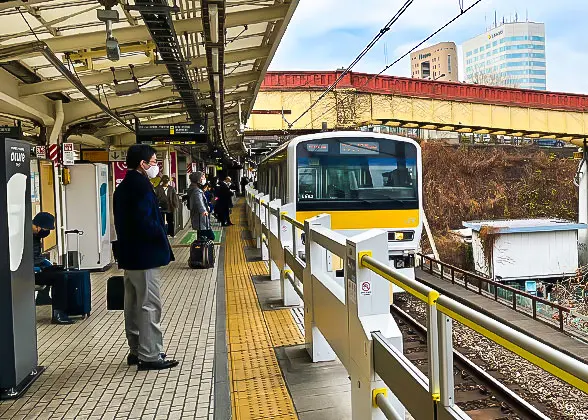 |
| JR Train |
Ordinary JR
JR, short for Japan Railways, represents the traditional trains except for Shinkansen at most times in Japan. Ordinary JR train is much slower than Shinkansen, especially those running for long-distance trips. As the railways are operated by different companies in different regions, you need to make a transfer once when the railway changes. From Tokyo to Osaka, you may spend 9-10h on the way and make 4-8 transfers; but it’s cheap, costing about 8,750 yen (USD 64).
JR Pass/Seishun 18
JR issues Rail Pass for foreign visitors, which allow them to take Shinkansen and ordinary trains unlimitedly during the specified times. It requires visitors to book or buy JR Pass before the entry to Japan. There are JR Pass for Gran Class or ordinary class. The specified times include 7 days, 14 days, and 21 days of nationwide JR Pass. Moreover, according to travel regions, one can also buy JR Pass of the corresponding region, which is on sale with a span of more flexible days. However, it is not permitted to take Nozomi and Mizuho trains of Shinkansen. For the nationwide JR Pass, the official price is 44,810 yen (USD 328.5) for an adult’s 7-day ticket, twice that for a child.
Seishun 18 is another special ticket of JR trains, but it can merely be utilized for non-reserved seats on ordinary trains. Visitors can’t use it to take Shinkansen or sleeping berths. A Seishun 18 ticket can be used for 5 times in total, that is, 1 person for 5 times or 5 persons for once. It takes 12,050 yen (USD 88.3) for adults.
Long-Distance Bus
Long-distance buses shuttle between big cities like Tokyo, Osaka or Nagoya in Japan and their surroundings. In particular, bus is the definitely great vehicle if you would like a countryside sightseeing. Multiple stations are usually available, so you can select the nearest one to get onboard, and get off at the closest stop to your destination. The bus between two metropolises is not cost-effective, for it takes as long time as ordinary trains but costs as high as plane tickets. Long-time sitting also makes the trip unpleasant.![]() Below are some popular routes around Tokyo for reference:
Below are some popular routes around Tokyo for reference:
The buses between Tokyo and Mt. Fuji/Lake Kawaguchi take 2-2.5h and 2,000-2,390 yen (USD 14.7-15.6); between Shinjuku of Tokyo and Hakone take 2-2.5h and 2,480 yen (USD 18.3) for the whole trip; between Nikko and Narita Airport take 3h and 2,800-4,300 yen (USD 21-32).
From Osaka, you can get to Kyoto, Kinosaki, Arima, Kobe, Wakayama, Nara, and more stops. From Nagoya, Chubu Centrair Airport, Shingu/Kumano in Mie, Takayama, etc. can be reached. In central mountainous region, Nohi Bus operates many routes around Takayama and Shirakawa-go, making your tour to the world cultural heritage sites easier. It runs from and to Kanazawa, Takaoka, Toyama, Matsumoto, Guji-Hachiman, Gero, Gifu, Nagoya, and even farther Kyoto, Osaka, and Tokyo.
|
|
Subway
Subway is a convenient way to travel within large cities in Japan, and the developed underground transportation network allows visitors to reach many attractions in the city smoothly. Tokyo, Osaka and Nagoya have the well-developed subway system, and some other cities own several subway routes of its own, too. For example, there are Tokyo Metro lines and Toei lines in Tokyo, covering the entire city. 24-hour, 48-hour, and 72-hour tickets for Tokyo subway system are user-friendly, which permits unlimited rides within the corresponding periods. Besides, Tokyo Subway Navigation is a useful APP to help you find out the subway line to ride and the relevant price.
City Bus
City bus is widely used and convenient as well in a city, especially when you make a short trip. The city bus system has denser stops than subway. Thus, it takes longer time than subway for a same route. The 1-day ticket for city bus is practicable likewise. There is a button on handrails or/and seats; when the bus is getting to the stop that you are about to get off, press the button to tell the driver. By the way, you could experience the tramcar in Japan as remains of old times, such as Toden Arakawa line, or called Tokyo Sakura Tram, in Tokyo. It is not only a mode of transport, but also a way to trace the life of before.
In addition, sightseeing bus is optional to shuttle among the attractions in a city. Sky Bus Tokyo, Sky Duck, Sky Hop Bus Tokyo, and Hato Bus show you around Tokyo. Hato Bus giving the pick-up service and English guided tour, becomes more and more popular among Tokyo tourists.
Taxi
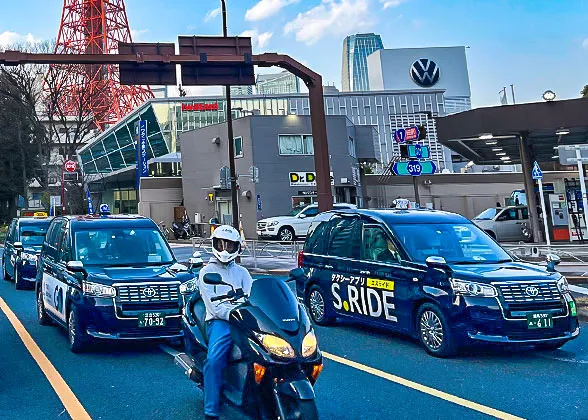 |
| Taxies in Tokyo |
Taxi is perhaps the most expensive mode of transport, also the most flexible and convenient. According to the size of taxies, the number of passengers is prescribed differently. The flag-fall price (the basic fee within 2 km (1.24 mi)) is also different from city to city, but it’s similar basically. In general, the flag-fall fee is about 780 yen (USD 5.8) during daytime in Tokyo, and 100 yen (USD 0.74) is added every 300 meters (328 yards) or so. If you take a taxi at night from 23:00 pm to 5:00 am the next day, the fare is increased by 30%. There is also extra charge when driving on expressway.
Ferry/Cruise
The cruise from the city ashore to offshore islands is always an important transportation in Japan. There are large steamboats and ferryboats from Takeshiba Pier, Tokyo to Izu and Ogasawara islands. In Niigata, the 1-hour ferry will take you to Sado Island for island exploration. When visiting Okinawa, cruise from the main island to circumjacent offshore islands is also welcomed for fun at sea.
Transportation Cards
There are some transportation cards in Japan, allowing holders to take train, subway, city bus or more transportation modes operated by different corporations. Nowadays, a few popular cards becomes valid for nationwide use, such as Suica, PASMO, and ICOCA cards.
Around Tokyo, Suica and PASMO cards are common. Suica card can be used on ordinary trains, subway lines, and city bus ran by JR East Company. Meanwhile, Suica card is also practicable in convenience stores. You could buy a Suica card on a ticket machine or ticket office at main JR stations in Tokyo, and it is a type of recharging card with a deposit of 500 yen (USD 3.7). PASMO card is similar to Suica, but it is issued by Tokyo Metro. Accordingly, PASMO card is applied for transportation vehicles by Tokyo Metro. These two cards can’t be utilized to take Shinkansen, and remember they can’t be used in Kansai region.
In Kansai region, ICOCA card issued by JR West Company is mostly used. You can get an ICOCA card only in Kansai, and it is practicable nationwide, including Kanto region.
